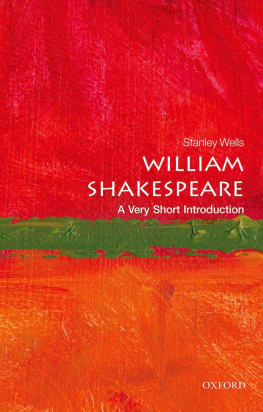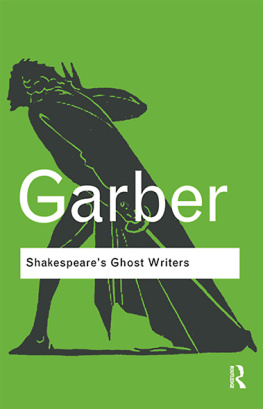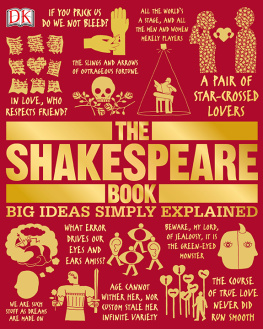Shakespeare An Ungentle Life
Shakespeare An Ungentle Life
Katherine Duncan-Jones

Contents
PLATES (collected between pp. 172 and 173)
1 The Ditchley portrait of Queen Elizabeth I standing on a map of England, by Marcus Gheeraerts the Younger, c. 1592 (National Portrait Gallery).
2 William Holes illustration to the Thirteenth Song in Draytons Polyolbion (1612), showing Warwickshire and the Forest of Arden, from a coloured copy once in the possession of Elizabeth of Bohemia (Bodleian Library).
3 Venus carried heavenward in a dove-drawn chariot; engraving by Bernieri after Raphael, 1786 (Mary Evans Picture Library).
4 Shakespeares coat of arms; frontispiece to C. W. Scott-Giles, Shakespeares Heraldry, London, 1950 (British Library).
5 Shakespeares disputed coat of arms, on the left, with the arms of Mauley, Harley and Ferrers for comparison on the right (Bodleian Library).
6 Panel painting of the siege of Troy, by Biagio di Antonio, Florence, c. 1490 (Fitzwilliam Museum, University of Cambridge, UK/Bridgeman Art Library).
7 On the right, forged coat of arms awarded by William Dethick to Parr the Embroiderer, with the authentic Parr family arms shown on the left (Folger Shakespeare Library).
8 Effigy of the poet John Gower in Southwark Cathedral, formerly St Saviours (Robert Aberman).
9 Portrait of Robert Devereux, second Earl of Essex, by Nicholas Hilliard (National Portrait Gallery).
10 Queen Elizabeth being carried in procession, painting by Robert Peake, c. 1600; the grey-haired man in the foreground, wearing the Garter below his knee, may be Shakespeares patron, the second Lord Hunsdon, the Lord Chamberlain (Private Collection/Bridgeman Art Library).
11 Funeral procession of Queen Elizabeth, possibly drawn by William Camden (British Library, London, UK/Bridgeman Art Library).
12 Title-page of Draytons Polyolbion (1612), showing an allegorical figure of Great Britain seen through a triumphal arch; from a coloured copy once in the possession of Elizabeth of Bohemia (Bodleian Library).
FIGURES
.
.
.
.
.
.
.
.
.
.
.
.
.
.
.
.
.
.
.
.
.
.
.
.
.
.
.
.
.
.
.
.
.
.
.
.
.
.
.
.
.
.
.
.
.
Courage is required in defying Shakespeares gravestone curse on any false friend who presumes to dig the dust that encloses his mortal remains in Holy Trinity Church, Stratford-upon-Avon, as well as considerable doggedness. It is widely claimed that virtually nothing is known about Shakespeares extra-literary life. To many non-academics it may seem that writing yet another biographical study is just the sort of footling self-indulgence on which people like me are believed to spend their time. However, the labours of such great scholars as Edmond Malone, E. K. Chambers and Samuel Schoenbaum have shown that we possess a substantial body of documents relating to Shakespeares life, especially considering that he did not enjoy institutional affiliation to a college, a city company, an Inn of Court or a parish church, that might have connected him with a body of well-preserved archival records. Surviving documents dont take us far in answering the kind of questions that Romantic and post-Romantic readers may want to pose did Shakespeare love his wife? who was the dark lady? what was his religious position or his overall vision of the world? However, they include life records ranging from the poets baptism to his death, with much in between that relates to Shakespeares family, his property and litigation. There is also a wealth of contemporary allusions to Shakespeare as player and poet, and to his writings, both poems and plays. Indeed, this material is so abundant that I have not attempted to cite it all. It will be discussed and explored much more fully in my next book, a study of Shakespeares lifetime reputation and status entitled From Crow to Swan.
Here, I have relied heavily on Schoenbaums two great works, his Documentary Life (1975) and Records and Images (1981). The availability of these books, in which most of the major documents are reproduced in facsimile, makes it wonderfully easy for students to examine images of such material as Shakespeares will, or the depositions in the BelottMountjoy suit.
My aim in Ungentle Shakespeare, when it was first published in 2001, was to explore areas of Shakespeares life that Schoenbaum and others neglected, and to choose the road less travelled for preference. While Schoenbaum sidestepped certain topics because of reluctance to speculate, I risked conjecture, and attempted to clothe those well-guarded bones with some spectral flesh. I knew that in so doing I was exposing myself to challenge or flat disbelief. Yet it seemed worth trying, experimentally, to bring Shakespeare down from that lofty isolation to which he has so often been elevated in the past, and to consider him as a man among men, a writer among writers. There is no doubt that his manifest brilliance laid him open to envy and malice on the part of less gifted individuals.
I also hoped to break down the artificially imposed boundaries that have so often separated Shakespeare from his contemporaries, while also suggesting some of the ways in which they and their writings had an impact on him. This seemed an especially worthwhile enterprise because of recurrent suggestions that Shakespeare was a provincial hick who couldnt truly have written the works to which his name was attached.
My method has been more thematic than narrative. Rather than trawling events and writings in precise chronological sequence, I have identified topics or issues connected to particular periods. This can be seen in the chapter titles. For instance, in the opening chapter, rather than starting with the statement that Shakespeare was born , I have positioned his birth and boyhood within the cultural context of the Midlands in the 1560s and 1570s, drawing attention both to the many other talented men of letters produced by the region and to its abundance of dramatic activities. Some may wish for a fuller and more straightforward narrative, including an account of every play and work. However, many conventionally structured biographies are available, such as Park Honans full and careful Shakespeare: A Life (1998), the most recent biography to follow the conventions established by Sidney Lee, E. K. Chambers and Samuel Schoenbaum. My hope was that, rather than providing a comprehensive reference work, I might be able to stimulate new readers to explore the historical and cultural world within which Shakespeare had his being more widely than previous generations have done. I hope that some such readers may be drawn to follow up, develop or challenge connections that I have traced between Shakespeare and other writers, such as Thomas Nashe, Ben Jonson, John Marston, George Wilkins and John Fletcher. In order to reach young readers I felt that I needed to produce something shorter, fresher and perhaps less daunting than full biographies such as Honans. Given my target, I am of course especially delighted that the book is now at last appearing in paperback, and will be within the reach of students. Both the Arden 3 Poems (2007) and the revised and updated Arden 3
Next page





